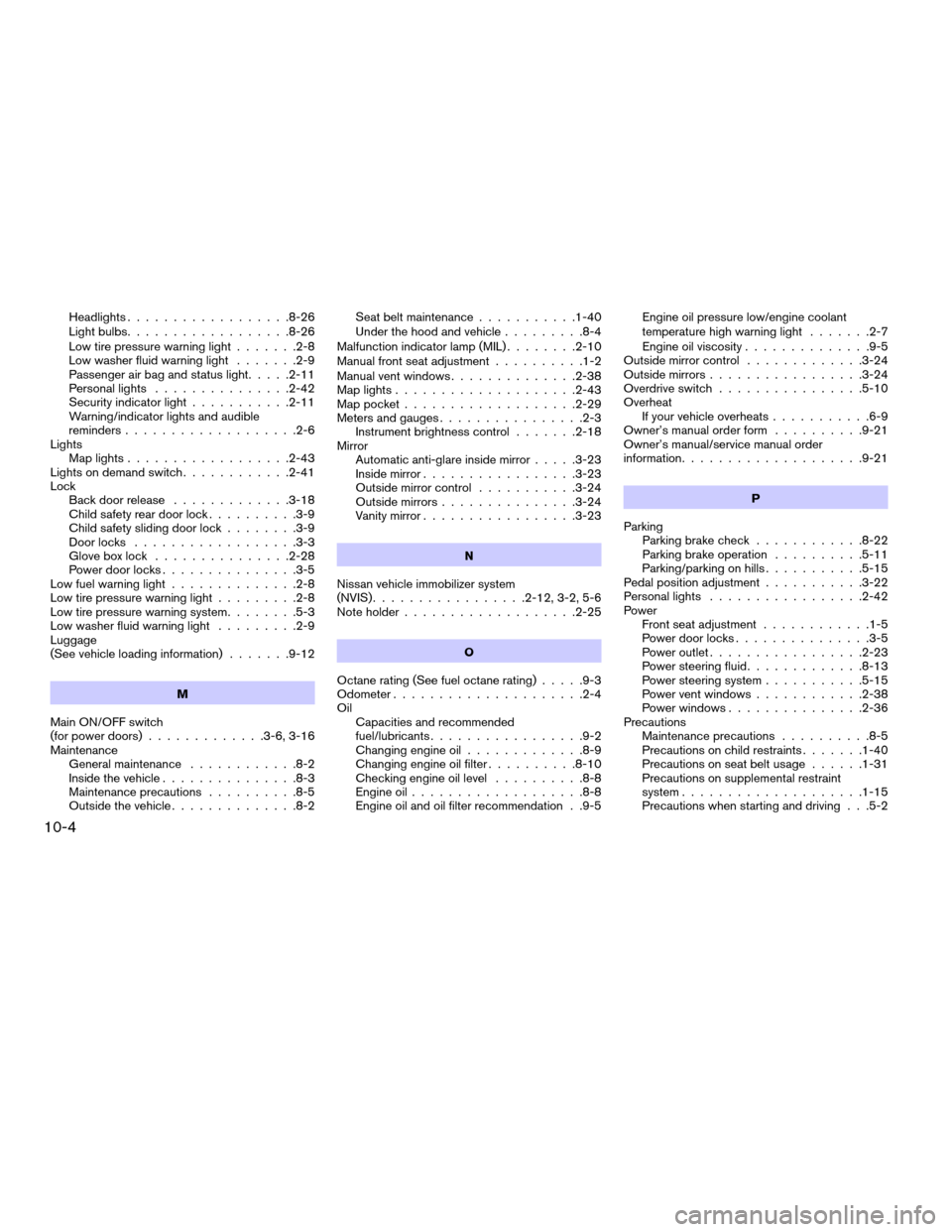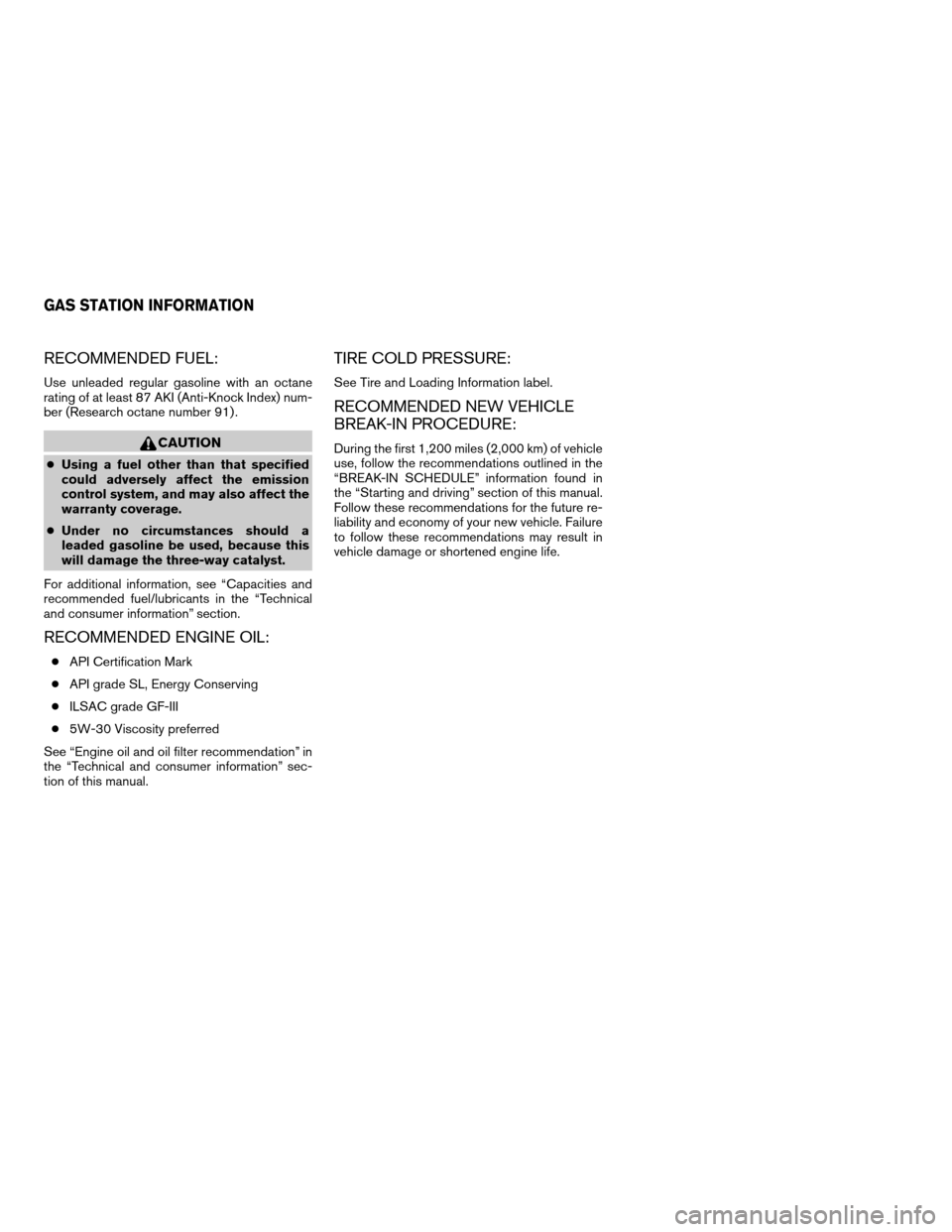2004 NISSAN QUEST oil
[x] Cancel search: oilPage 291 of 320

ENGINE OIL AND OIL FILTER
RECOMMENDATION
Selecting the correct oil
It is essential to choose engine oil with the cor-
rect quality and viscosity to ensure satisfactory
engine life and performance. NISSAN recom-
mends the use of a low friction oil (energy con-
serving oil) in order to improve fuel economy and
conserve energy. Oils which do not have the
specified quality label should not be used as they
could cause engine damage.
Only those engine oils with the American Petro-
leum Institute (API) CERTIFICATION MARK onthe front of the container should be used. This
type of oil supersedes the existing API SG, SH, or
SJ and Energy Conserving II categories.
If you cannot find engine oil with the API CERTI-
FICATION MARK, use API grade SL Energy
Conserving oil. An oil with a single designation
SL, or in combination with other categories (for
example, SL/CF) may also be used if one with the
API CERTIFICATION MARK cannot be found. An
ILSAC grade GF-III oil can also be used.
NISSAN recommends mineral based oils. These
oils must, however, meet the API quality and SAE
viscosity ratings specified for your vehicle.
Oil additives
NISSAN does not recommend the use of oil
additives. The use of an oil additive is not neces-
sary when the proper oil type is used and main-
tenance intervals are followed.
Oil which may contain foreign matter or has been
previously used should not be used.
Oil viscosity
The engine oil viscosity or thickness changes
with temperature. Because of this, it is important
to select the engine oil viscosity based on the
temperatures at which the vehicle will be oper-
ated before the next oil change. The chart “Rec-
ommended SAE viscosity number” shows the
recommended oil viscosities for the expected
ambient temperatures. Choosing an oil viscosity
other than that recommended could cause seri-
ous engine damage.
Selecting the correct oil filter
Your new NISSAN vehicle is equipped with a
high-quality genuine NISSAN oil filter. When re-
placing, use a genuine NISSAN oil filter or its
equivalent for the reason described in “Change
intervals”.
WTI0082
Technical and consumer information9-5
ZREVIEW COPY:Ð2004 Quest(van)
Owners Manual(owners)ÐUSA English(nna)
10/08/03Ðtbrooks
X
Page 292 of 320

Change intervals
The oil and oil filter change intervals for your
engine are based on the use of the specified
quality oils and filters. Using engine oil and filters
that are not of the specified quality, or exceeding
recommended oil and filter change intervals
could reduce engine life. Damage to the engine
caused by improper maintenance or use of incor-
rect oil and filter quality and/or viscosity is not
covered by the NISSAN new vehicle warranty.
Your engine was filled with a high-quality engine
oil when it was built. You do not have to change
the oil before the first recommended change
interval. Oil and filter change intervals depend
upon how you use your vehicle.
Operation under the following conditions may
require more frequent oil and filter changes:
crepeated short distance driving at cold out-
side temperatures
cdriving in dusty conditions
cextensive idling
ctowing a trailer
RECOMMENDED SAE VISCOSITY
NUMBER
cSAE 5W-30 viscosity oil is preferred for all
temperatures. SAE 10W-30 or SAE
10W-40 viscosity oils may be used if the
ambient temperature is above 0°F (-18°C) .
AIR CONDITIONER SYSTEM
REFRIGERANT AND LUBRICANT
RECOMMENDATIONS
The air conditioner system in your NISSAN
vehicle must be charged with the refriger-
ant HFC-134a (R-134a) and the lubricant,
NISSAN A/C system oil DH-PS or the exact
equivalents.
CAUTION
The use of any other refrigerant or lubri-
cant will cause severe damage to the air
conditioning system and will require the
replacement of all air conditioner system
components.
The refrigerant HFC-134a (R-134a) in your
NISSAN vehicle does not harm the earth’s ozone
layer. Although this refrigerant does not affect the
earth’s atmosphere, certain government regula-
tions require the recovery and recycling of any
refrigerant during automotive air conditioner sys-
tem service. A NISSAN dealer has the trained
technicians and equipment needed to recover
and recycle your air conditioner system refriger-
ant.
Contact a NISSAN dealer when servicing your air
conditioner system.
ATI1028
9-6Technical and consumer information
ZREVIEW COPY:Ð2004 Quest(van)
Owners Manual(owners)ÐUSA English(nna)
10/08/03Ðtbrooks
X
Page 303 of 320

cWhen going down a hill, shift into a lower
gear and use the engine braking effect.
When going up a long grade, downshift the
transmission to a lower gear and reduce
speed to reduce chances of engine over-
loading and/or overheating. However, for
long steep grades, do not stay in 1st gear
when driving above 35 MPH (55 km/h) or
2nd gear when driving above 58 MPH (93
km/h) .
cIf the engine coolant rises to an extremely
high temperature when the air conditioner
system is on, turn off the air conditioner.
Coolant heat can be additionally vented by
opening the windows, switching the fan
control to high and setting the temperature
control to the HOT position.
cTrailer towing requires more fuel than normal
circumstances.
cAvoid towing a trailer for your vehicle’s first
500 miles (805 km) .
cFor the first 500 miles (805 km) that you do
tow, do not drive over 50 MPH (80 km/h) .
cHave your vehicle serviced more often than
at intervals specified in the recommended
Maintenance Schedule in the “NISSAN Ser-
vice and Maintenance Guide”.cWhen making a turn, your trailer wheels will
be closer to the inside of the turn than your
vehicle wheels. To compensate for this,
make a larger than normal turning radius
during the turn.
cCrosswinds and rough roads will adversely
affect vehicle/trailer handling, possibly caus-
ing vehicle sway. When being passed by
larger vehicles, be prepared for possible
changes in crosswinds that could affect ve-
hicle handling. If swaying does occur, firmly
grip the steering wheel, steer straight ahead,
and immediately (but gradually) reduce ve-
hicle speed. This combination will help sta-
bilize the vehicle. Never increase speed.
cBe careful when passing other vehicles.
Passing while towing a trailer requires con-
siderably more distance than normal pass-
ing. Remember, the length of the trailer must
also pass the other vehicle before you can
safely change lanes.
cTo maintain engine braking efficiency and
electrical charging performance, do not use
overdrive.
cAvoid holding the brake pedal down too long
or too frequently. This could cause the
brakes to overheat, resulting in reduced
braking efficiency.When towing a trailer, final drive gear oil
should be replaced and transmission
oil/fluid should be changed more fre-
quently. For additional information, see the
“Maintenance and do-it-yourself” section
earlier in this manual.
FLAT TOWING
Towing your vehicle with all four wheels on the
ground is sometimes called flat towing. This
method is sometimes used when towing a vehicle
behind a recreational vehicle, such as a motor
home.
CAUTION
cFailure to follow these guidelines can
result in severe transmission damage.
cWhenever flat towing your vehicle, al-
ways tow forward, never backward.
cDO NOT tow any automatic transmis-
sion vehicle with all four wheels on the
ground (flat towing) . Doing so WILL
DAMAGE internal transmission parts
due to lack of transmission lubrication.
cFor emergency towing procedures refer
to “Towing recommended by NISSAN”
in the “In case of emergency” section of
this manual.
Technical and consumer information9-17
ZREVIEW COPY:Ð2004 Quest(van)
Owners Manual(owners)ÐUSA English(nna)
10/08/03Ðtbrooks
X
Page 310 of 320

Child restraints.......1-33, 1-34, 1-40, 1-51
Precautions on child restraints.......1-40
Top tether strap anchor point locations . .1-54
Child safety rear door lock............3-9
Child safety sliding door lock..........3-9
Chimes, audible reminders...........2-12
Cleaning exterior and interior..........7-2
Clock
(models with navigation system)......4-14
(models without navigation system).....4-4
Cold weather driving..............5-21
Compact disc (CD) player...........4-37
Control panel buttons
With navigation system...........4-8
Without navigation system..........4-2
Controls
Audio controls (steering wheel)......4-41
Heater and air conditioner
controls................4-17, 4-27
Rear audio controls.............4-43
Rear seat air conditioner..........4-29
Convenience hook...............2-29
Coolant
Capacities and recommended
fuel/lubricants.................9-2
Changing engine coolant..........8-8
Checking engine coolant level........8-7
Engine coolant temperature gauge.....2-4
Cornering light.................2-19
Corrosion protection...............7-5
Cruise control..................5-12
Cup holders...................2-32
Curtain side-impact air bag system
(See supplemental side air bag and curtain
side-impact air bag system)..........1-27D
Daytime running light system
(Canada only)..................2-18
Defroster switch
Rear window and outside mirror
defroster switch...............2-15
Digital video disc DVD.............4-44
Dimensions and weights.............9-8
Door locks....................3-3
Door open warning light.............2-7
Drive belts....................8-16
Drive positioner, Automatic...........3-25
Driving
Cold weather driving............5-21
Driving with automatic transmission.....5-7
Precautions when starting and driving . . .5-2
DVD entertainment system...........4-44
E
Economy - fuel.................5-14
Emission control information label.......9-10
Emission control system warranty.......9-19
Engine
Before starting the engine..........5-6
Capacities and recommended
fuel/lubricants.................9-2
Changing engine coolant..........8-8
Changing engine oil.............8-9
Changing engine oil filter..........8-10
Checking engine coolant level........8-7
Checking engine oil level..........8-8Engine compartment check locations. . . .8-7
Engine coolant temperature gauge.....2-4
Engine cooling system............8-7
Engine oil...................8-8
Engine oil and oil filter recommendation . .9-5
Engine oil viscosity..............9-5
Engine serial number............9-10
Engine specifications.............9-7
Starting the engine..............5-7
Engine oil pressure low/engine coolant
temperature high warning light.........2-7
Exhaust gas (Carbon monoxide)........5-2
Eyeglass case..................2-28
F
Flashers
(See hazard warning flasher switch)......2-20
Flat tire......................6-2
Floor mat positioning aid.............7-4
Fluid
Automatic transmission fluid (ATF). . . .8-11
Brake fluid..................8-13
Capacities and recommended
fuel/lubricants.................9-2
Engine coolant................8-7
Engine oil...................8-8
Power steering fluid.............8-13
Window washer fluid............8-14
F.M.V.S.S. certification label..........9-10
Fog light switch.................2-19
Front air bag system
(See supplemental restraint system).....1-22
Front seats....................1-2
10-2
ZREVIEW COPY:Ð2004 Quest(van)
Owners Manual(owners)ÐUSA English(nna)
10/08/03Ðtbrooks
X
Page 312 of 320

Headlights..................8-26
Light bulbs..................8-26
Low tire pressure warning light.......2-8
Low washer fluid warning light.......2-9
Passenger air bag and status light.....2-11
Personal lights...............2-42
Security indicator light...........2-11
Warning/indicator lights and audible
reminders...................2-6
Lights
Map lights..................2-43
Lights on demand switch............2-41
Lock
Back door release.............3-18
Child safety rear door lock..........3-9
Child safety sliding door lock........3-9
Door locks..................3-3
Glove box lock...............2-28
Power door locks...............3-5
Low fuel warning light..............2-8
Low tire pressure warning light.........2-8
Low tire pressure warning system........5-3
Low washer fluid warning light.........2-9
Luggage
(See vehicle loading information).......9-12
M
Main ON/OFF switch
(for power doors).............3-6, 3-16
Maintenance
General maintenance............8-2
Inside the vehicle...............8-3
Maintenance precautions..........8-5
Outside the vehicle..............8-2Seat belt maintenance...........1-40
Under the hood and vehicle.........8-4
Malfunction indicator lamp (MIL)........2-10
Manual front seat adjustment..........1-2
Manual vent windows..............2-38
Map lights....................2-43
Map pocket...................2-29
Meters and gauges................2-3
Instrument brightness control.......2-18
Mirror
Automatic anti-glare inside mirror.....3-23
Inside mirror.................3-23
Outside mirror control...........3-24
Outside mirrors...............3-24
Vanity mirror.................3-23
N
Nissan vehicle immobilizer system
(NVIS).................2-12, 3-2, 5-6
Note holder...................2-25
O
Octane rating (See fuel octane rating).....9-3
Odometer.....................2-4
Oil
Capacities and recommended
fuel/lubricants.................9-2
Changing engine oil.............8-9
Changing engine oil filter..........8-10
Checking engine oil level..........8-8
Engine oil...................8-8
Engine oil and oil filter recommendation . .9-5Engine oil pressure low/engine coolant
temperature high warning light.......2-7
Engine oil viscosity..............9-5
Outside mirror control.............3-24
Outside mirrors.................3-24
Overdrive switch................5-10
Overheat
If your vehicle overheats...........6-9
Owner’s manual order form..........9-21
Owner’s manual/service manual order
information....................9-21
P
Parking
Parking brake check............8-22
Parking brake operation..........5-11
Parking/parking on hills...........5-15
Pedal position adjustment...........3-22
Personal lights.................2-42
Power
Front seat adjustment............1-5
Power door locks...............3-5
Power outlet.................2-23
Power steering fluid.............8-13
Power steering system...........5-15
Power vent windows............2-38
Power windows...............2-36
Precautions
Maintenance precautions..........8-5
Precautions on child restraints.......1-40
Precautions on seat belt usage......1-31
Precautions on supplemental restraint
system....................1-15
Precautions when starting and driving . . .5-2
10-4
ZREVIEW COPY:Ð2004 Quest(van)
Owners Manual(owners)ÐUSA English(nna)
10/08/03Ðtbrooks
X
Page 314 of 320

Supplemental air bag warning light . . .1-30, 2-9
Supplemental front impact air bag system . .1-22
Supplemental restraint system
Information and warning labels.......1-29
Precautions on supplemental
restraint system...............1-15
Supplemental restraint system
(Supplemental air bag system).........1-15
Supplemental side and curtain side-impact
air bag system..................1-27
Switch
Autolight switch...............2-16
Automatic power window switch.....2-37
Fog light switch...............2-19
Hazard warning flasher switch.......2-20
Headlight and turn signal switch......2-15
Ignition switch................5-5
Lights on demand switch..........2-41
Main ON/OFF switch
(for power doors)...........3-6, 3-16
Overdrive switch..............5-10
Power door lock switch...........3-5
Rear sonar system off switch.......2-22
Rear window and outside mirror
defroster switch...............2-15
Rear window wiper and washer
switches...................2-14
Traction control system (TCS) off
switch....................2-22
Vehicle dynamic control (VDC) off
switch....................2-22
Windshield wiper and washer switch . . .2-13T
Tachometer....................2-4
Temperature gauge
Engine coolant temperature gauge.....2-4
Engine oil pressure low/engine coolant
temperature high warning light.......2-7
Theft (Nissan vehicle immobilizer system) ,
engine start..............2-12, 3-2, 5-6
Third row bench seat adjustment.....1-8, 1-9
Three-way catalyst................5-2
Tilting steering wheel..............3-21
Tire
Flat tire....................6-2
Spare tire................6-3, 8-39
Tire chains..................8-36
Tire placard.................9-11
Tire pressure................8-31
Tire rotation.................8-37
Types of tires................8-36
Uniform tire quality grading.........9-18
Wheels and tires..............8-31
Wheel/tire size................9-8
Tire pressure
Low tire pressure warning light.......2-8
Top tether strap child restraint.........1-53
Towing
Flat towing..................9-17
Tow truck towing..............6-10
Towing load/specification chart......9-15
Trailer towing................9-14
Traction control system (TCS) off switch . . .2-22
Transceiver
HomeLinkTUniversal Transceiver.....2-43Transmission
Automatic transmission fluid (ATF). . . .8-11
Driving with automatic transmission.....5-7
Selector lever lock release..........5-9
Travel (See registering your vehicle in another
country)......................9-9
Turn signal switch (See headlight and
turn signal switch)............2-15, 2-19
U
Umbrella holder.................2-30
Uniform tire quality grading...........9-18
V
Vanity mirror...................3-23
Vehicle dimensions and weights........9-8
Vehicle dynamic control (VDC) off switch. . .2-22
Vehicle dynamic control (VDC) system. . . .5-19
Vehicle identification...............9-9
Vehicle identification number (VIN)
(Chassis number).................9-9
Vehicle identification number (VIN) plate. . . .9-9
Vehicle loading information...........9-12
Vehicle recovery..............6-12, 7-2
Vehicle security system
(Nissan vehicle immobilizer system) ,
engine start..............2-12, 3-2, 5-6
Ventilators....................4-17
Visors......................3-22
10-6
ZREVIEW COPY:Ð2004 Quest(van)
Owners Manual(owners)ÐUSA English(nna)
10/08/03Ðtbrooks
X
Page 315 of 320

W
Warning
Air bag warning light.........1-30, 2-9
Anti-lock brake warning light........2-6
Battery charge warning light.........2-7
Brake warning light..............2-7
Door open warning light...........2-7
Engine oil pressure low/engine coolant
temperature high warning light.......2-7
Hazard warning flasher switch.......2-20
Low fuel warning light............2-8
Low tire pressure warning light.......2-8
Low washer fluid warning light.......2-9
Seat belt warning light............2-8
Warning labels (for SRS)..........1-29
Warning/indicator lights and audible
reminders...................2-6
Warning lights..................2-6
Washer switch
Rear window wiper and washer
switches...................2-14
Windshield wiper and washer switch . . .2-13
Weights (See dimensions and weights). . . .9-8
Wheels and tires................8-31
Wheel/tire size..................9-8
When traveling or registering your vehicle
in another country................9-9
Window washer fluid..............8-14
Windows
Locking passengers’ windows.......2-37
Manual vent windows............2-38
Power vent windows............2-38
Power windows...............2-36
Windshield wiper and washer switch.....2-13Wiper
Rear window wiper and washer
switches...................2-14
Windshield wiper and washer switch . . .2-13
Wiper blades................8-19
10-7
ZREVIEW COPY:Ð2004 Quest(van)
Owners Manual(owners)ÐUSA English(nna)
10/08/03Ðtbrooks
X
Page 319 of 320

RECOMMENDED FUEL:
Use unleaded regular gasoline with an octane
rating of at least 87 AKI (Anti-Knock Index) num-
ber (Research octane number 91) .
CAUTION
cUsing a fuel other than that specified
could adversely affect the emission
control system, and may also affect the
warranty coverage.
cUnder no circumstances should a
leaded gasoline be used, because this
will damage the three-way catalyst.
For additional information, see “Capacities and
recommended fuel/lubricants in the “Technical
and consumer information” section.
RECOMMENDED ENGINE OIL:
cAPI Certification Mark
cAPI grade SL, Energy Conserving
cILSAC grade GF-III
c5W-30 Viscosity preferred
See “Engine oil and oil filter recommendation” in
the “Technical and consumer information” sec-
tion of this manual.
TIRE COLD PRESSURE:
See Tire and Loading Information label.
RECOMMENDED NEW VEHICLE
BREAK-IN PROCEDURE:
During the first 1,200 miles (2,000 km) of vehicle
use, follow the recommendations outlined in the
“BREAK-IN SCHEDULE” information found in
the “Starting and driving” section of this manual.
Follow these recommendations for the future re-
liability and economy of your new vehicle. Failure
to follow these recommendations may result in
vehicle damage or shortened engine life.
GAS STATION INFORMATION
ZREVIEW COPY:Ð2004 Quest(van)
Owners Manual(owners)ÐUSA English(nna)
10/08/03Ðtbrooks
X